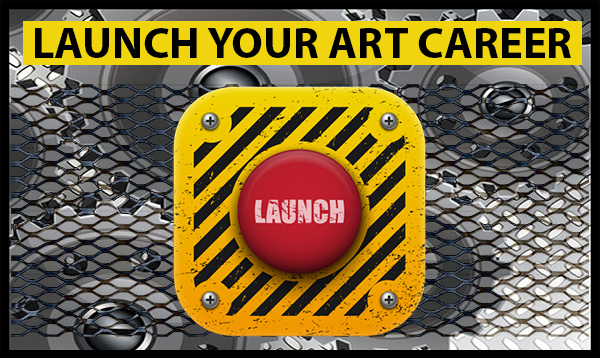 Have you ever wondered why there are so many starving artists in the world? Or why so many of your favorite high profile, Instagram-famous artists still need a day job to make ends meet?
Have you ever wondered why there are so many starving artists in the world? Or why so many of your favorite high profile, Instagram-famous artists still need a day job to make ends meet?
The reason is really pretty simple. Most artists know an awful lot about making art, but don’t have a clue about making money. It’s not their fault.
If you’re a self taught artist, you probably haven’t spent much time learning about business. Hell, even if you’re an institutionally educated artist, you went to school to learn art, not business.
It’s a rare breed of artist indeed that knows enough about making art and about building a business too. But you’re in luck, because if truth be told, I am in fact, a rare breed indeed.
Over the next several posts, I’m going to show you exactly how to build a real business with your art. My new years resolution to you is to give you everything you need to double or triple whatever online sales you made last year, and I resolve to start right now.
The Key to a Successful Art Business
Look, if you want to build a business around your art, a real business that generates real income for you and provides real value for your customers, you have to understand business.
Making great drawings or tattoos or cards or whatever isn’t enough to build a business. Having a store to sell your work or putting your work on lots of products isn’t enough either. Neither is running a blog, collecting emails, or building your audience on social media.
These things are not a business.
Now don’t get me wrong, you need to have most, if not all, of the things I’ve mentioned above. You can’t have an art business if you aren’t making art or building an audience, you can’t create sales if you don’t have a store or a diversified set of products to sell, and you can’t connect to your audience if you don’t have social media, an email list, or both. You absolutely DO need those things to build a business, but those things are not a business in and of themselves. Those things are tools. We use those tools to build the model for our business.
According to Webster’s, a business model is:
a design for the successful operation of a business, identifying revenue source, customer base, products, and details of financing.
A few weeks back, I outlined a business model for artists in the ‘Art Marketing That Doesn’t Suck’ post.
Each of the resources outlined in the above diagram are the tools we need to build the model, but to operate the model we need a business plan.
To start the new year off right, I’m going to give you the business plan that makes this model work. Don’t worry, I’ll get back to discussing the individual parts of the model soon, but the parts are just tools, and tools in and of themselves are useless unless you know how to use them.
Business Plan
A business plan is a strategy that indicates a business’s goals and an actionable plan for achieving those goals using the tools identified in the business model.
This is a business plan:
We will use this plan in conjunction with the model to clearly define our path. Over the next few weeks, we will be jumping back and forth between the plan and model. In the end we should have a clear plan and a working model to demonstrate these concepts.
Ultimately our goal is to build a successful art business that will not only pay for itself month over month, but will also turn a profit. To do that, our business must do what every other successful business does.
Any business, no matter the specific industry it’s in, must do three things in order to survive and flourish:
- Increase its customer base
- Increase the average transaction amount per customer
- Increase the number of transactions per customer
We can’t have a business without customers, but acquiring new customers takes time, money, or both. (Most often both.) Getting new customers is a crucial part of the plan, but in and of itself it’s not enough. In order to make our business profitable, we need a way to incentivise each customer we have to buy more of what we have to offer, and to buy from us more often than once.
In order to do that, we need to spend some time on the first step of the business plan above – market research.
Getting to Know Your Customers
First off, it’s important to realize that a customer is only a customer AFTER they’ve bought something from you. Anyone who has not yet made a purchase is a lead.
In this system, we use Instagram to acquire leads. Each new follower we get is a new lead or potential customer, but some leads have a greater potential to become customers than others. That’s why targeting quality leads or followers is so important. If we use Instagram to build our potential customer base (leads), then it stands to reason we want as many followers as possible. More followers equals more potential customers. But… in order for our leads to become customers, they need to be genuinely interested in what we have to offer.
If all we needed was tons of followers, we could use any of those products that guarantee thousands of followers each week. You know, the ones that have a huge list of people that will follow you if you follow them back? Using a service like this would get us tons of new followers, but most of those followers would have little or no interest in buying our art. No good.
Even if we have only quality followers who we know are interested in our art, it still won’t do us any good if we don’t know who they are, how they like to express themselves, and what types of products they buy to show their individuality.
What we need to do is get to know our potential customers.
Demographics Pro
The best tool I’ve found to discover who your current followers are and what they like to do is Demographics Pro. With this tool, you simply enter your Instagram account name, pay a fee based on how many followers you have, and click to get your results. For the fee you pay, you’ll get up to 30 pages of detailed information on your current Instagram followers. Things like…
- average age and gender
- average income
- geographic location
- what brands they interact with most
- hobbies
- interests
etc…
With this information, we can start to build a successful business by learning what products our audience is likely to buy, and at what price points. Not knowing who their audience is and what they like is the biggest mistake most businesses make, and the reason most businesses fail.
Once we’ve learned who our audience is and what they like, we can not only target our products to fit our market, but we can actively target other people with similar interests to build our audience to fit our products. To illustrate how to do this and the value you’ll get from doing it, I’ll analyze my personal account with Demographics Pro for you to see.
Analyze Your Existing Audience With Demographics Pro
If we look at the stats, we can see that my audience is split nearly 50/50 between male and female. The average age of my audience is 23.4 years old with an average income of $28.2K per year. 61% of my audience lives in the US. But since 39% are outside the US, I’ll need to make sure to offer international shipping.
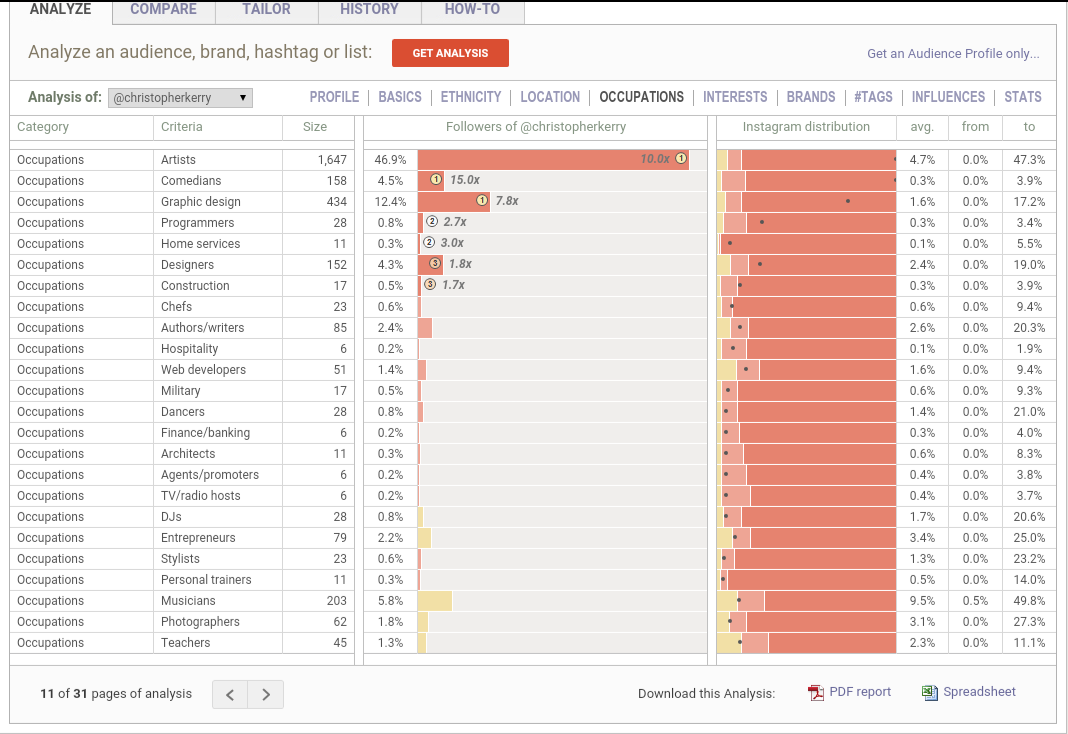 Professionally, my audience is composed mostly of other artists, graphic designers, and even though this chart doesn’t show it, tattoo artists.
Professionally, my audience is composed mostly of other artists, graphic designers, and even though this chart doesn’t show it, tattoo artists.
Their interests are mostly art/culture, but also I need to pay attention to that “collecting things” column. There’s not a large percentage of collectors, so prints are probably not really going to be a staple product for me. They do like books, gaming, and pets though, so art books of my collected drawings, coloring books, device cases, and possibly my art on pet clothing, are all probably pretty good choices.
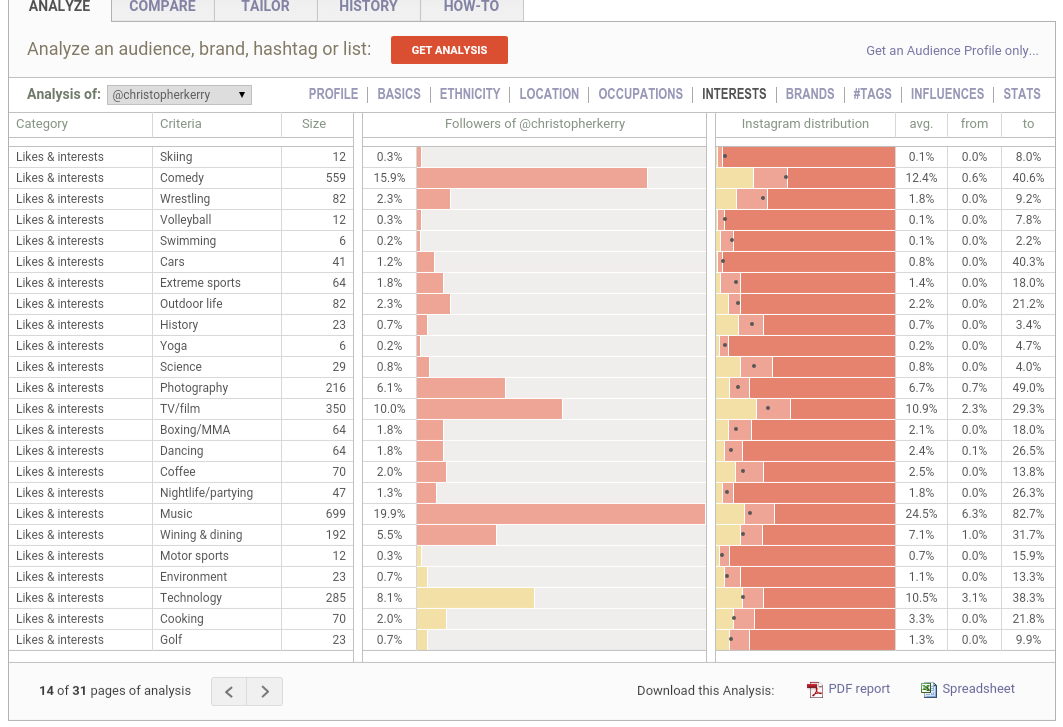 Looking deeper into their interests, I see comedy, TV/film, and a huge interest in music. From this I can deduce that whimsical, fantasy drawings will appease the TV/film interests, which if you’ve seen my personal work, you already know is right up my ally.
Looking deeper into their interests, I see comedy, TV/film, and a huge interest in music. From this I can deduce that whimsical, fantasy drawings will appease the TV/film interests, which if you’ve seen my personal work, you already know is right up my ally.
I am surprised to see so much interest in the music category.
The music thing is something I had not considered, so that opens up a whole bunch of new possibilities. I should definitely make stickers to go on guitars, amps, and cases. My art on guitar picks would be pretty awesome, and putting my work on concert style t-shirts is clearly a must.
More interesting still, I should probably contact some of the musicians I know and do some CD cover art for them. I could probably have a category on my store for custom album covers that would bring in another untapped source of commissions.
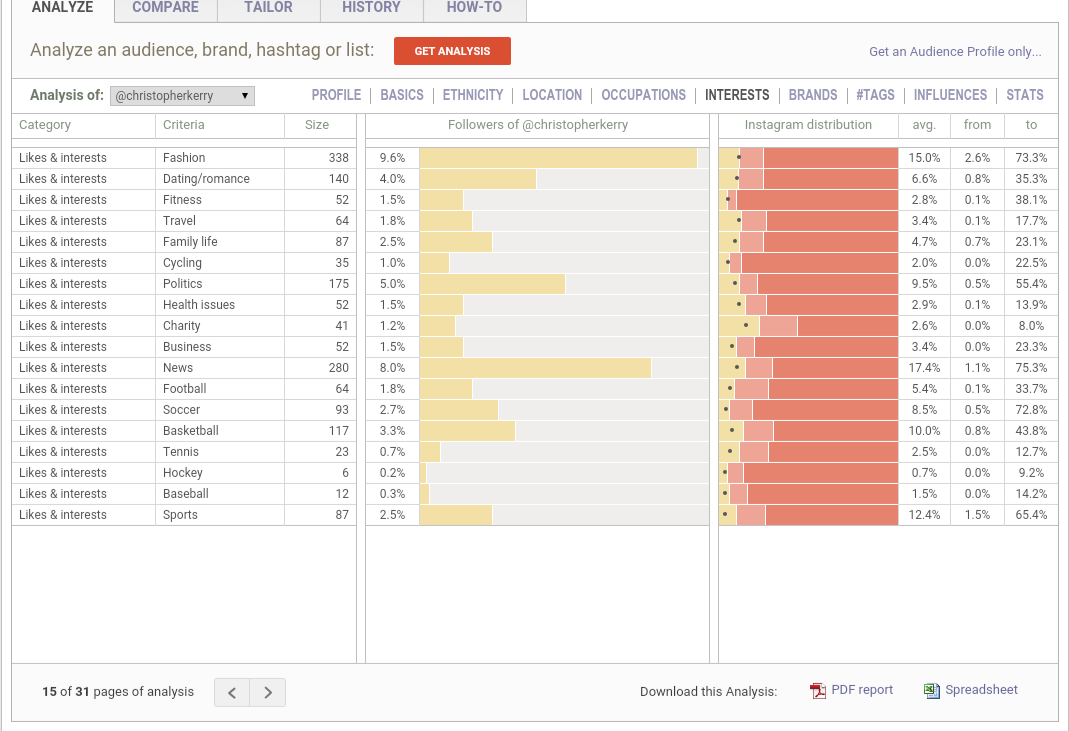 There’s also a large fashion interest, so t-shirts, hoodies, leggings, tote bags, etc. are all pretty good bets.
There’s also a large fashion interest, so t-shirts, hoodies, leggings, tote bags, etc. are all pretty good bets.
When I take a look at what brands are most popular with my audience (from the image above and from the right column of the first image), I can see Marvel, Nintendo, Juxtapoz, Inked Magazine, Threadless, The Oatmeal, and Hot Topic are all tipping the scales. Further proof that t-shirts, especially all-over printed t-shirts, are going to be good for me.
Finally, I can get an idea of where to target more followers by looking at the hashtag information. If I’m not using the tags that have the biggest bars here, I should be. I can also get a sense of what type of art I need to be making to resonate with this audience. There are more pages than what I’ve shown here, but over all, the tags my audience likes to use most are realism, watercolor, manga, pinup, drawing, and tattoo. So manga influenced pinup style drawings with touches of realistic color and tattoo line-work are really going to resonate. Sounds just like what I love to draw.
Given what I now know about my audience, I have a really good idea of what to sell and how much to sell it for. Based on the statistics above, I should most likely be selling:
- all-over printed t-shirts, both male and female
- hoodies
- device cases (for the gamers)
- stickers
- art books
- coloring books
- leggings
- tote bags
- guitar picks
With this assortment of products, I’ll have an easy time offering a variety of price points from low to high. Given that the average income of my audience is $30K or less, my low-end price point should be below $20, and my upper-end price point probably can’t go much above $75. Obviously I can offer higher priced luxury items, and I probably should. I just can’t depend on them to be regular sellers.
As you can see, a lot can be learned from using this tool to analyze your audience to ensure that you’re offering the right products to the right people at the right price.
What if you don’t have many followers?
Up to this point, we’ve talked about how to analyze your Instagram followers to determine who your prospects are and what products you might want to offer them. But how can you determine what your market wants if you don’t have a market yet?
Well, here’s how…
If you’re fairly new to Instagram, or just haven’t spent much time actively working to build your followers, you can still do market research. Honestly, the best time to do market research is before you start a business in the first place, so don’t worry, you’re in a perfect spot. But the strategy is different for you than the one laid out above.
If you have 300 followers or more, the Demographics Pro approach is the one you should start with, but even if you’ve done the research above, you should still do this step too since it has a tendency to add more insight and give you more knowledge than the statistics alone.
Identify Your Target Audience Without Demographics Pro
If you don’t have a large audience and would like to be able to identify who would be a good fit for your account, you need look no further than your own Instagram. But in this case, rather than look at the people who follow you, you should take a good look at the people you are following.
I’m talking about the big boys here, the movers and shakers, the famous Instagram artists you follow because you love their work, the guys you look up to and learn from. Because these guys have influenced your work, your art has elements in common with theirs, which means people who like their work will most likely show an interest in yours as well.
The big guys’ followers can become your audience too if you target them specifically and work to bring them over to your account. In a future post we will talk about how to automate this targeting, but if you want to start targeting them manually right now, you can use the techniques we’ve already discussed here and here.
But this post is not about targeting, it’s about researching. So go ahead and identify your influences and write down their Instagram account name and the name of the website they link to. Seriously. Write that shit down. Start a notebook. You need to write down at least three, and five would be better. Got em? Good.
Now that you know who the biggest artists in your niche are, it’s time to take a good look at their accounts. We want to take a look at the type of posts they put on their account. Are they posting mostly finished art? Do they post very many WIPs? Are they running any contests? Do they offer anything for sale, and if so, what kind of products? Write all of this down. Don’t get discouraged if they don’t have many or any products for sale on their Instagram. Most professionals don’t. But if they do, be sure to write it down. You’ll probably want to offer a similar product.
Now it’s time to head on over to their website. Take a good look at the different pages they have in the navigation bar. You know, the one that links to the home page, store page, etc. If they have anything unusual up there, write it down. You may want to add a similar page to your store later.
Now let’s take a good look at what kinds of products they’re offering. What are their prices? How many products do they have? Are most of their products aimed at a specific gender, or are they mostly unisex products? Which products would you personally buy? Write all of this information down and anything else that catches your eye.
Be thorough, it’s important. The things that are on their site represent the types of items their audience buys, and since you’re going to be targeting their audience to bring them to your own account, these are the kinds of things your audience will buy once you’ve built it. Go through each of the artists you listed, one at a time, and write down every piece of information you can. When you’re done, if you’ve been thorough, you should have a pretty good idea of who your future audience will be and what kinds of things they will most likely buy.
To close out this section and the rest of this post, I’ll run through this process with one of the big boys in my niche (the sexy girl art niche).
For this example, I’m going to use one of my personal artistic heroes, Rockin Jelly Bean.
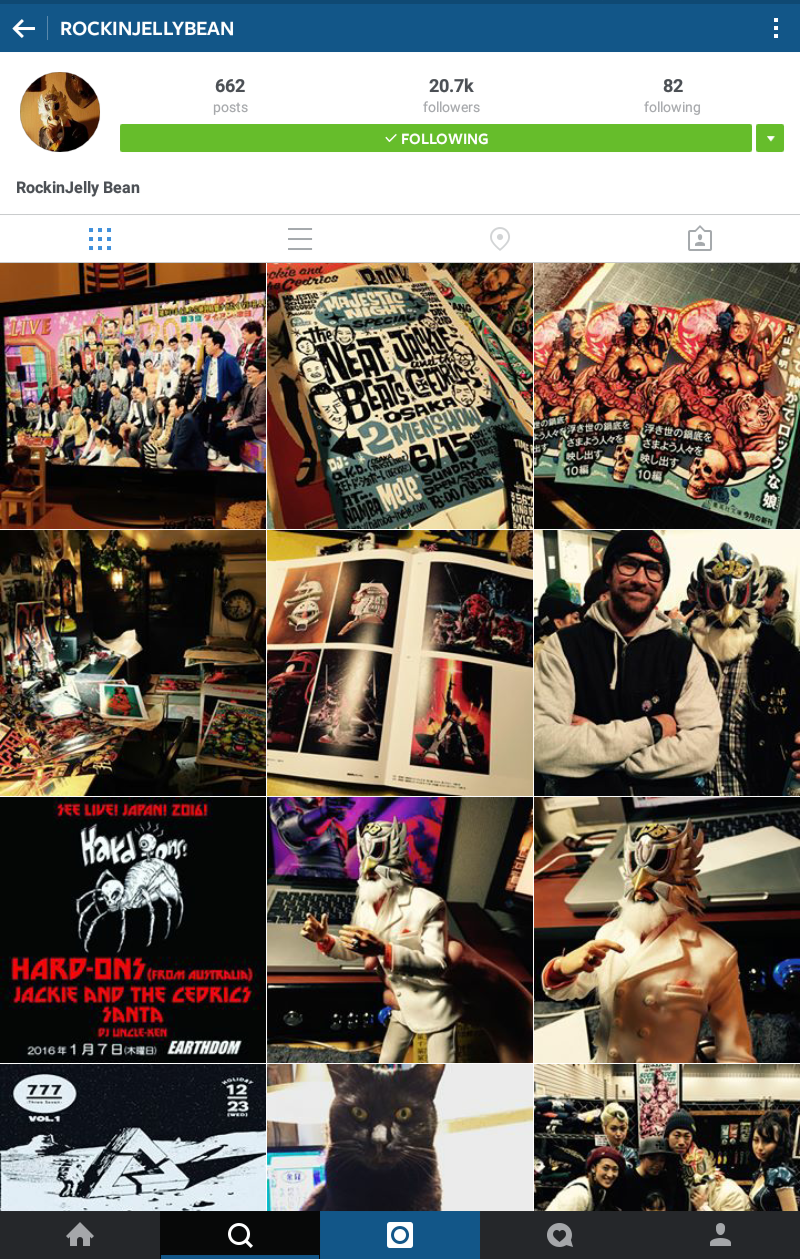
On his personal account, I can see that he is showing mostly prints. Actually, this account appears to be mostly a lifestyle account – more about his personal image and less about the images he makes. The fact that there isn’t a link to his website on this account just proves the point that this is all about promotion and not so much about sales. He’s a huge name in the industry, so that’s not surprising. He’s using this account to build a more personal connection with his audience. A behind the scenes, day in the life, if you will. Smart marketing when you’re as famous as he is, but not a lot of help for deducing what products I should be offering to his audience once I’ve targeted them. He does have over 20K followers though, and since we both draw sexy girls, I know for a fact that at least some of those people will like what I draw too. So I’ll write his account name down so I can target his followers later. Let’s see what else we can find.
I know for a fact that part of Rockin Jelly Bean’s brand identity is called Erostika, and a quick search of that name brings up this account.
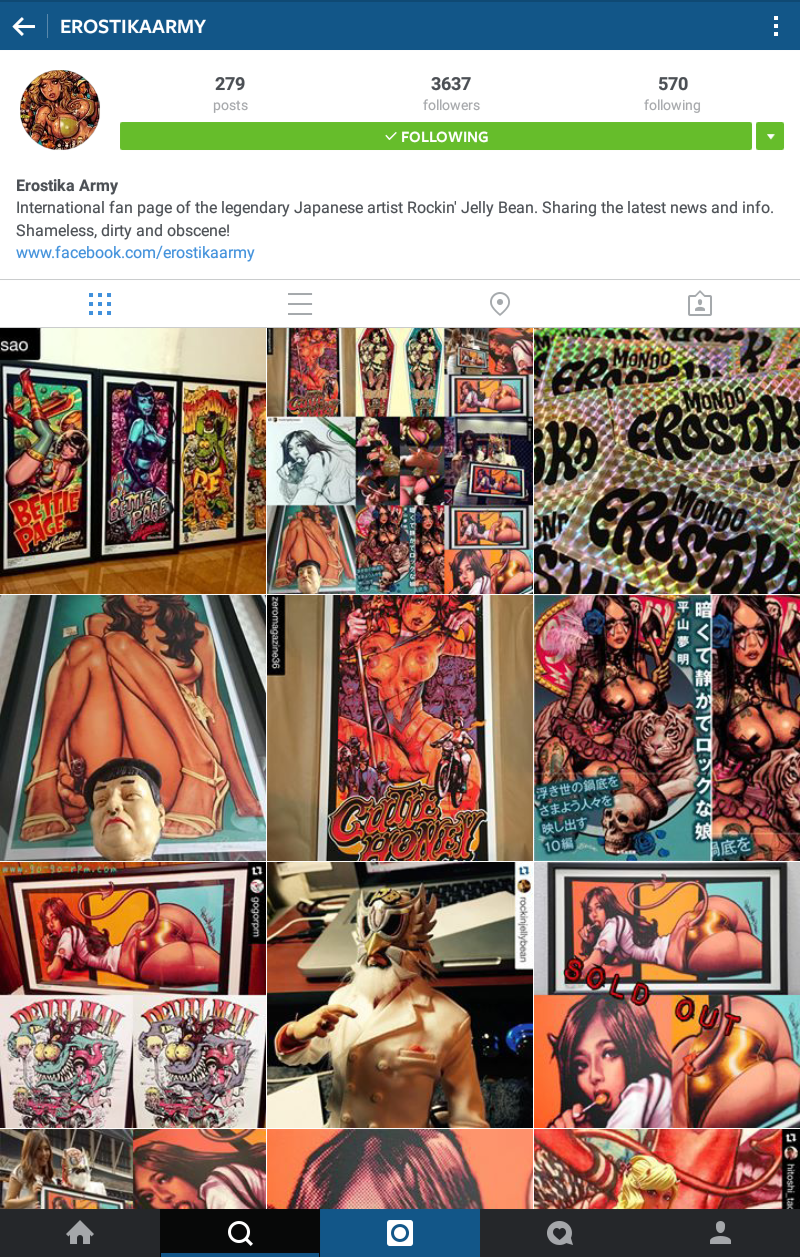
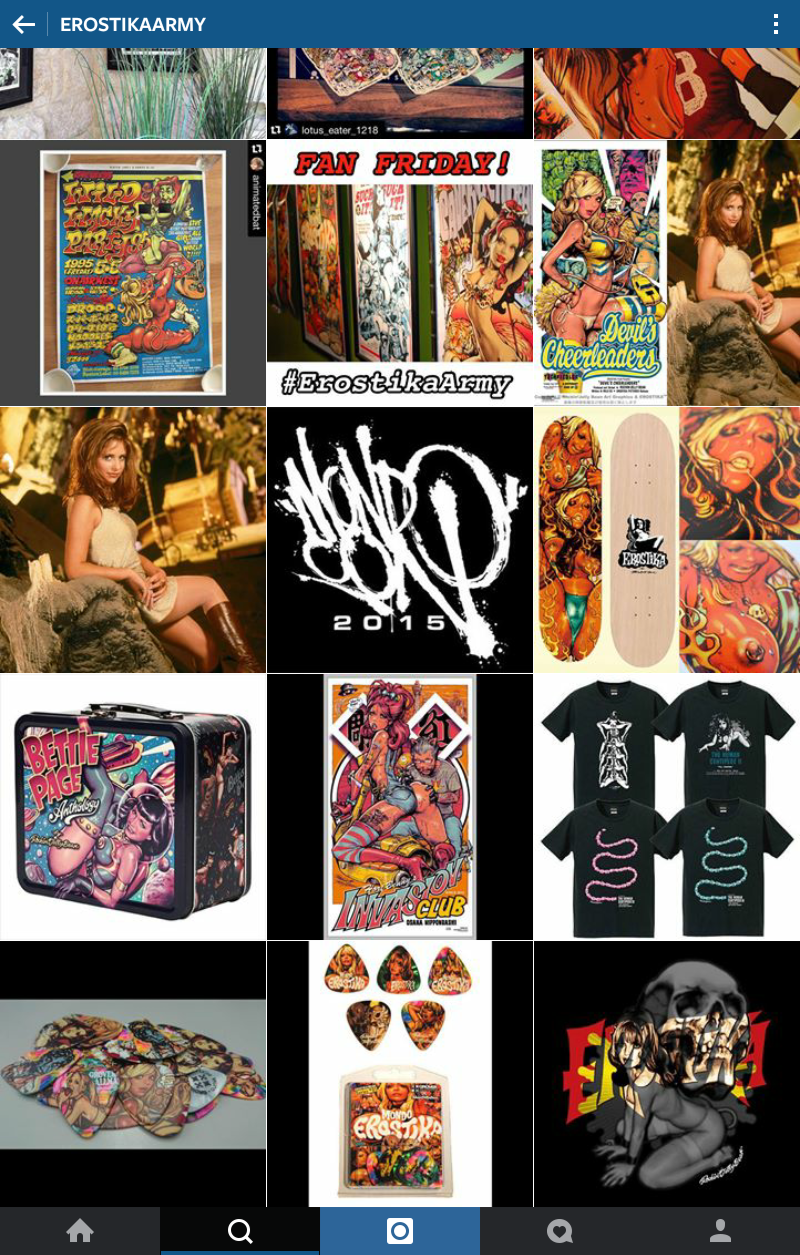
This account has way fewer followers, but if I scroll all the way down to their first post, I can see that they’ve only been posting for 21 weeks. So less than 4000 followers isn’t all that bad. I will want to target the followers of this account as well, but more importantly, there are tons of products here. At the bottom of the account I can see prints, posters, guitar picks, t-shirts, skate decks, and lunch boxes. I’ve never even considered lunch boxes. Cool!
I’m going to spend considerable time on this account, writing down everything that catches my eye. I know at least some of these people will like my work too, and since I’m going to be targeting them specifically, I know these will be good products to offer. Again, no outside link to a website, but I will check out the Facebook page later to see if I get any more ideas.
Finally, I’ll do a Google search (since there’s no website link) to find out Rockin Jelly Bean’s primary website.

The website is in Japanese, but that doesn’t matter because of Google Translator. I will literally spend hours here writing down pages and pages of info. But for now, let’s take a quick look at what products he’s selling.
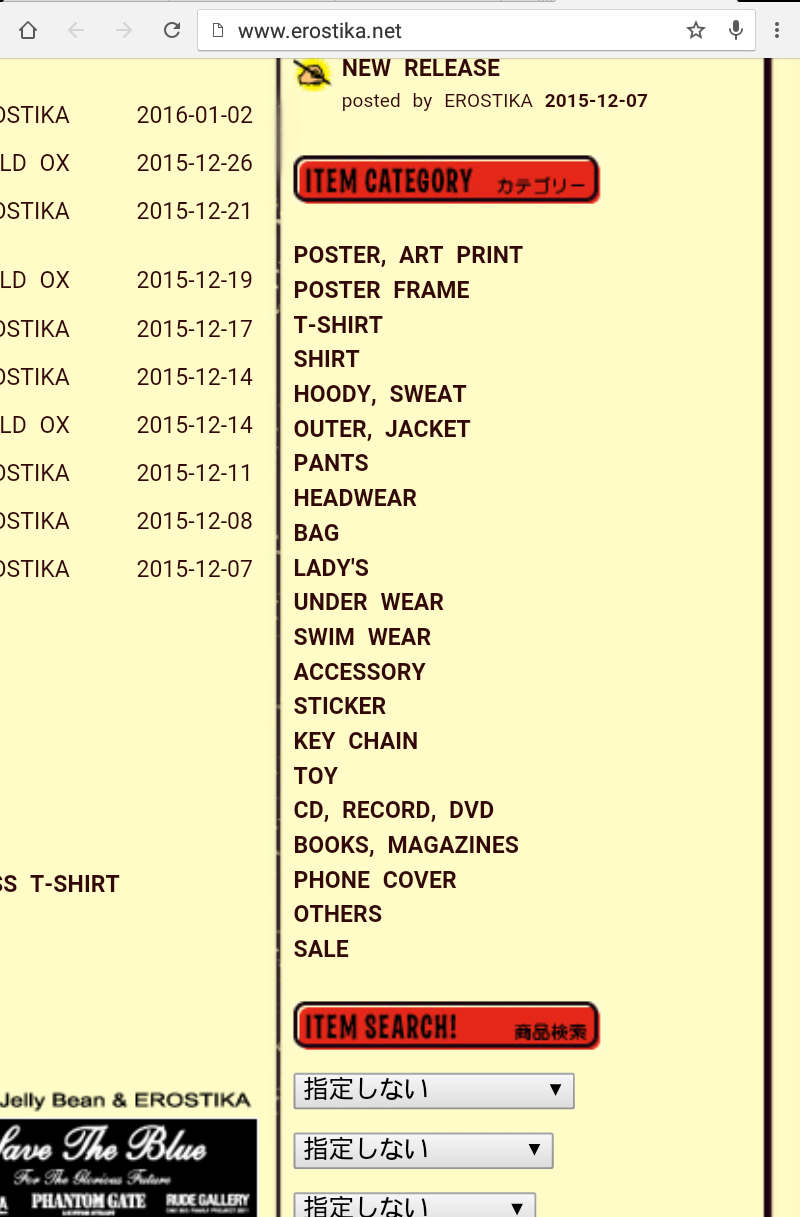
Posters, prints, jackets, underwear, swimwear (hadn’t thought of those), stickers, book, magazines, guitar picks, skate decks (from Instagram, remember?) A quick click on the underwear and swimwear items tells me they are sold out in all styles. Definitely need to consider adding those to my product lineup.
What’s interesting here is that if you compare this list to the products I identified using Demographics Pro, you’ll find that they are remarkably similar. Funny how that works out.
What Did We Learn?
So as you can see, with either approach, I arrive at a pretty extensive product list, tailored specifically to the audience I have, and/or the audience I am going to build. I am not just guessing who my audience is and what they might like. I know. I’ve done the research, and that my friends, is good business.
The bottom line is this – I’ve learned that most of my followers are a lot like me. We have plenty of interests in common like fantasy art, music, books, and cool comfy t-shirts. Personally, I also have a large collection of at least 30 leather jackets, which makes me wonder if my art on the back of a cool leather jacket would sell.. it would be a high priced item, but hell, I would buy it, so someone else probably would too. I wonder if any of the print on demand companies print on leather…
Ok, so there you have it. One long ass blog post that covers the first category of building a successful art business – market research.
Now that we have a good idea of what products to put our art on, next week we’ll take a look at the print on demand companies best suited to do the work. Until then, stay safe, and happy New Year.
Oh, and one more thing…
Look, I know that using Demographics Pro costs money. I spent nearly $50 to get the statistics I showed you here today, but given how much I learned and how much money I will save by not offering the wrong products to the wrong audience, it was well worth the cost. If you’re serious about building a successful art business, you are going to have to spend some money. You can trust me when I say that money spent getting to know your audience is well worth the cost. And remember, I am not affiliated with any of the products I recommend. I recommend them because they work, and in most cases, they are necessary to succeed.
As always, I’d love to hear what you think, and I’d especially love to hear your results if you use Demographics Pro to analyze your account. So sound off in the comments below and let me know you’re listening.
How helpful was this post?
1 Star: Oh man, that sucked… 5 Stars: Good God, it’s brilliant!

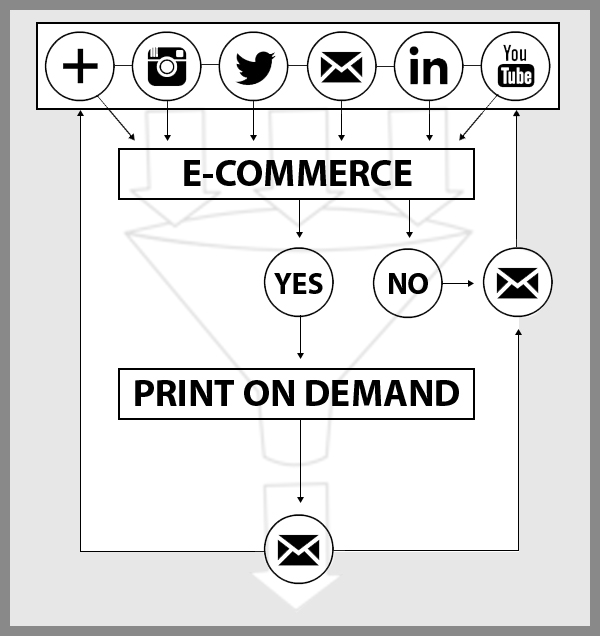
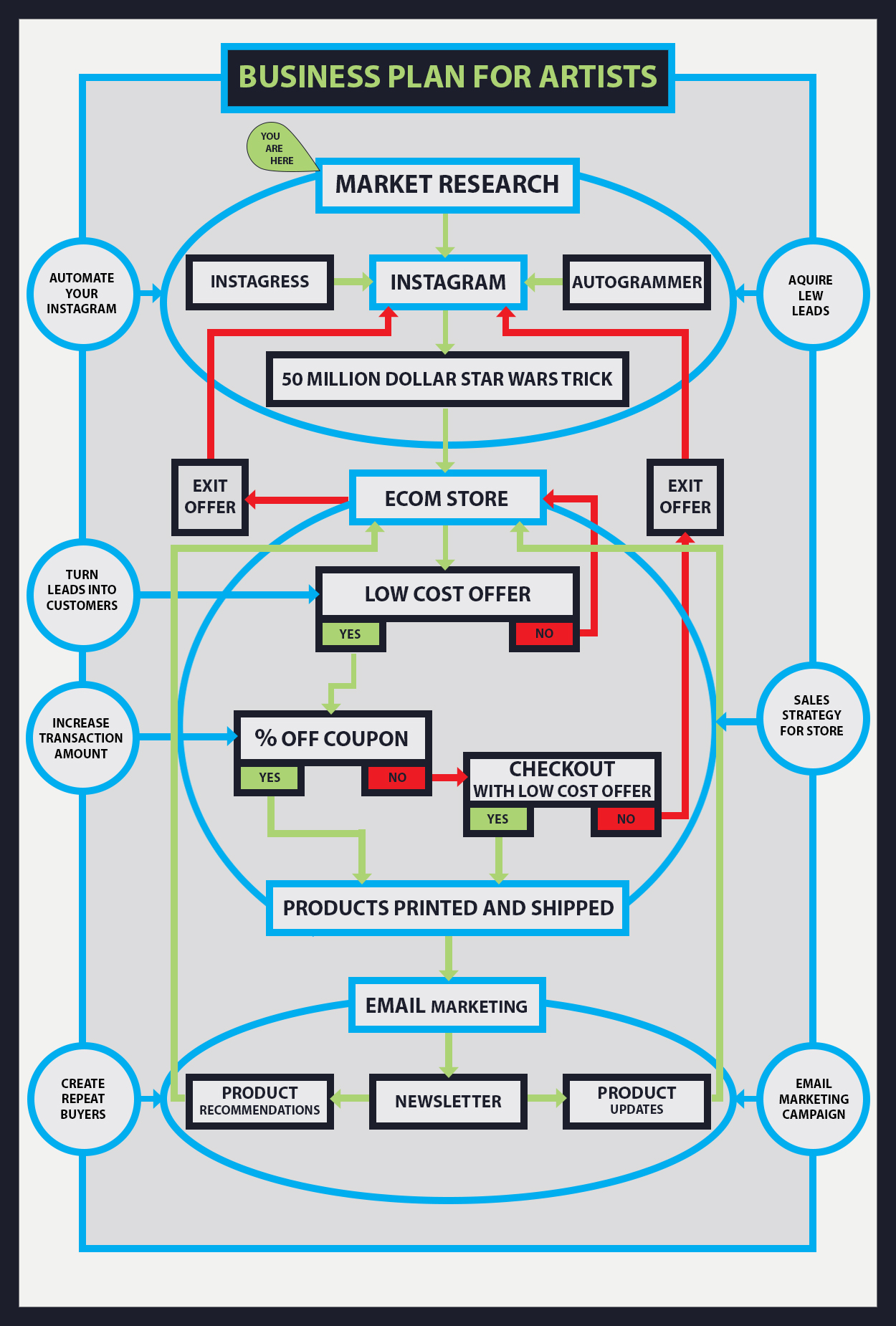
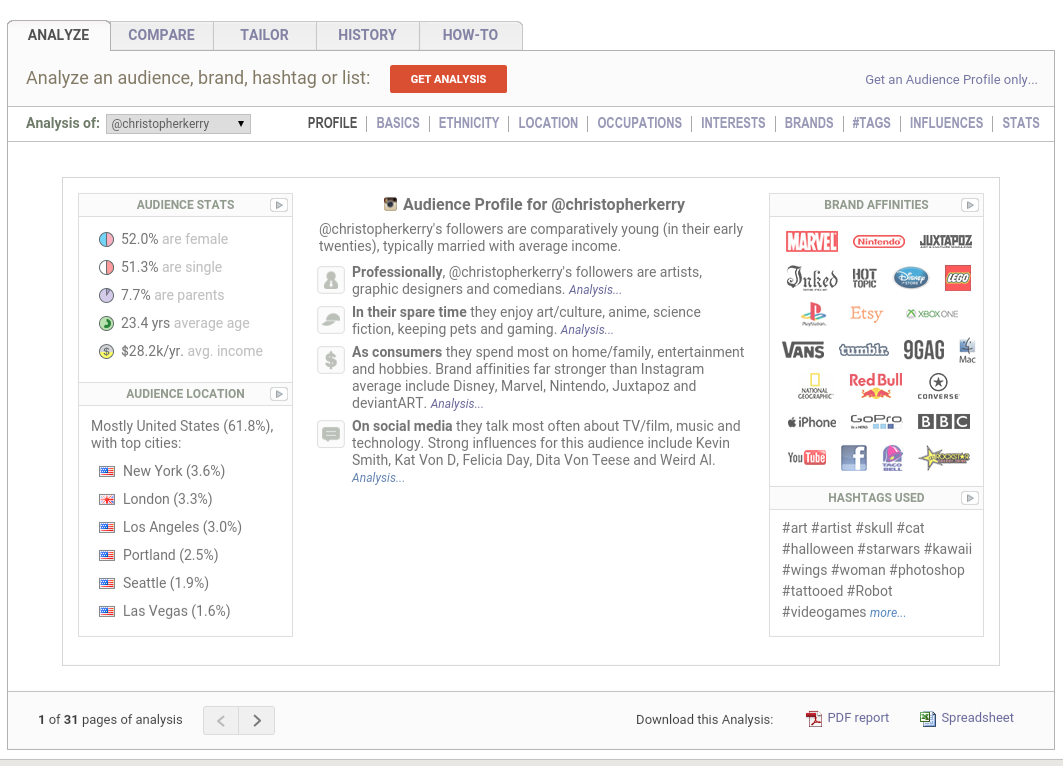
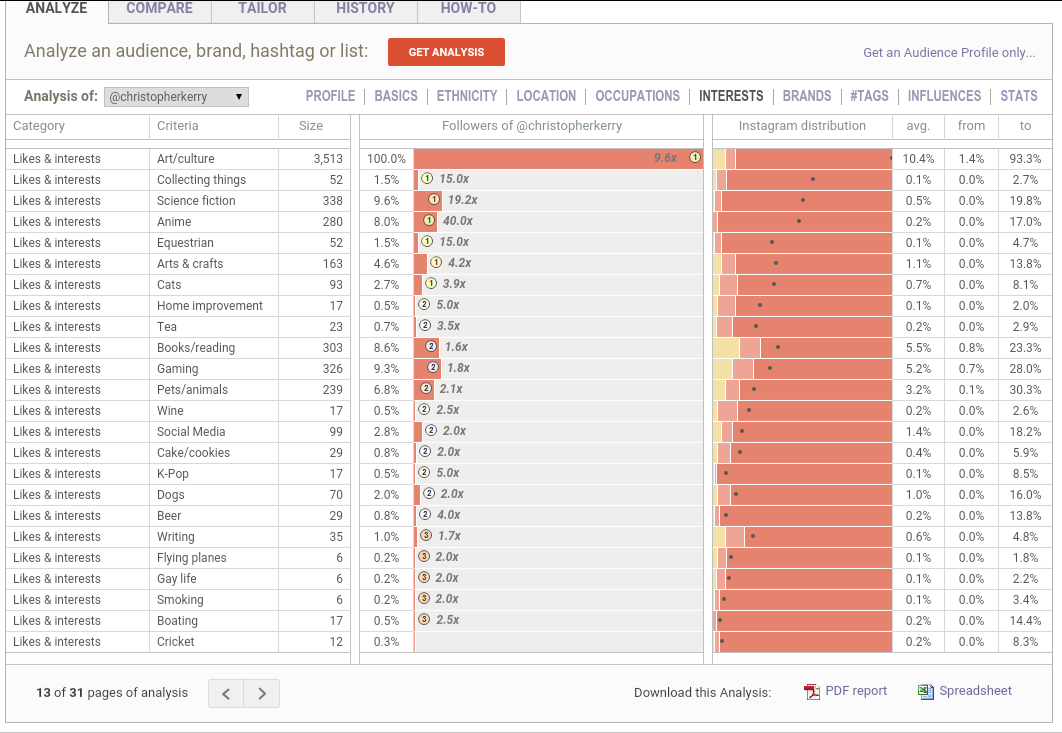





Wow, great posts! Thanks! Question – how many pieces do you think someone should have in their portfolio at launch?
Hi Alyson 🙂 if you’re thinking about launching a store the way I’m laying them out in these posts, you could reasonably start with less than five images. With all the product options I discuss in the most recent post, five images could give you well over 100 products. The most I would recommend is 10 to 12. That way you can see what is selling and replace the ones that aren’t selling well. I’m not a big fan of offering our customers TOO MANY choices. When there is too much it’s too easy for them to get overwhelmed and decide to not make any choice at all.
Chris, found you through TAA. I do sculpture, so a lot of these sales options don’t seem like they’d apply to me. I’ve looked at several other artists I like, and they mostly do what I do, which is to work on commission or to create their own designs and sell those works once completed. Any thoughts on how I might apply some of your ideas toward 3D work? Thank you!
Hi Tom, happy to have you here. I’ve done quite a bit of 3D work myself. Mostly bronze and you’re right, it IS different. I’ll put some thought into your question and see if I can come up with a solution.
Awesome post! It took me few days for me digest this post for me. I did try demographics pro. I am sure this little investment worth my money 🙂 so much to think about and on my to do list! thanks!
Hi Unky! So happy to hear you ran demographics! That’s the first step towards really understanding your audiance. Once you know who they are, giving them what they want is easy.
Let me know if you have any questions regarding the results! I’ll be happy to help 🙂
This post is amazing! You help me a lot.
Now my problem is I have selected two items for my target, and they are keychans an postcards with my manga design. But How can I find some good Print on Demand for them.
MissChroma, check out Makeable (print.io). If I’m not mistaken, they print on both of those items!
Wow, Christopher! This is so much better than… well, basically guessing and hoping. 😐
I had all but given up on the idea of marketung my artork online. But thanks to your help, I can see a way that this can work!
Im beginning to compile my research, and rereading this post as I do, to make sure I geg as much out f my efforts as possible.
Thanks for all the great information and advice. I at wait to see where this goes from here.
Can’t wait. LoL I must be excited.
Thanks man! Please keep us updated, I’ll be happy to help in any way I can!
Btw I’ve seen several people mention meeting you through TAA. I did a google search and I’m fairly certain they weren’t referring to Trade Adjustment Assistance. LoL
So what is TAA?
Mikey, TAA is an art marketing website and Facebook group. The initials stand for “The Abundant Artist”. You should check them out, there’s some pretty cool stuff there.
i was thinking about going into another industry when I got old enough (Teen at the moment) But I’m glad I can pursue my passion for art instead and make money off that.
Just wondering, is it possible to be a billionaire/millionaire off this technique?
have you made millions off of this?
Hi Anonymous, I’m glad this post has encouraged you to follow your passion! As to whether it’s possible to be a billionaire/millionaire using this approach, there are plenty of internet millionaires out there who would say “yes”. As for how much I’ve personally made, I think I’ll keep that anonymous 🙂 but I can tell you this is my only job.
Oh I see. Thanks!
I want to be a millionaire/billionaire one day… So what better way to do it than using what your passionate for?
Anyways, thank you for the information! ;^;
Pingback: An Artist’s Guide to Print on Demand
Hi Christopher! Thank you so much for doing for what you do!
Your marketing posts are priceless, in my opinion, for any artist starting out or expanding. Your information can help us from making wrong decisions in the first place. I’m a wildlife photographer and I’m looking for a perfect platform to sell wildlife prints on canvas, fine art paper,etc for different kinds of interiors.
I’ve read a lot of info on different sites including The Abundant Artist and based on what I’ve read I have a feeling Shopify is the way to go. Having read your posts , I’ve found proof that my guts are right. In this post you recommend to start only with not more than 5 works. Do you think these tactics for a person like me selling wildlife art? Should I not show the variety of my best work in this case? I try to post my best images on IG. Thanks again!